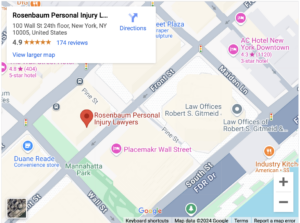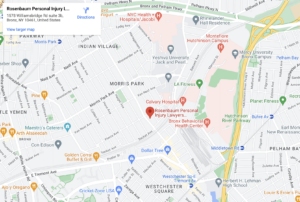Interstate Car Accidents in New York

Have you been hurt in a crash on the busy interstates in New York City, New York? How can you protect your rights after such a serious collision? The New York City car accident lawyers at Rosenbaum Personal Injury Lawyers understand New York’s no-fault system and fight tirelessly for crash victims. Call today at (212) 514-5007 for a free consultation with our experienced legal team.
How Rosenbaum Personal Injury Lawyers Can Help After an Interstate Car Accident in New York City, NY

Our New York City personal injury attorneys have over 40 years of combined experience offering legal guidance to car accident victims in New York City, NY. Since the firm’s founding, we’ve successfully recovered tens of millions of dollars in financial compensation for our clients.
After you suffer an injury in an interstate crash caused by someone else’s negligence, our New York City car accident lawyers can perform the following services:
- Investigating your accident and discussing possible legal strategies
- Building your case by gathering records and other evidence
- Submitting an insurance claim and working to settle it
- Pursuing a lawsuit against the other driver if we can’t negotiate a settlement
Interstate crashes can range in severity from minor to fatal, depending on the speed and road conditions. Contact us for a free consultation with a knowledgeable New York City interstate car accident attorney to learn about the compensation you can seek for your injury-related losses.
Types of Interstate Car Accidents
Interstate highways are different from city streets. Under federal design standards, interstate traffic must be separated with a median. Each direction must have two travel lanes of a prescribed width. These regulations are intended to facilitate high-speed traffic while protecting motorists from harm,
Since interstate highways lack intersections, side-impact and angle collisions are uncommon. Instead, accidents usually take the form of rear-end, sideswipe, and head-on collisions.
Head-On Crashes
Head-on crashes result from wrong-way driving. These can happen when confused, distracted, or intoxicated drivers enter the interstate through an off-ramp.
Sideswipe Collisions
Sideswipe collisions occur when one vehicle strikes the side of another. Unsafe lane changes are the most frequent cause of these mishaps. For example, a driver who changes lanes without checking their blind spots can easily sideswipe a vehicle in the next lane.
Rear-End Collisions
Rear-end collisions happen when drivers slam into the vehicles ahead of them.
They’re among the most common types of crashes and may result from the following causes:
- Tailgating
- Speeding
- Distracted driving
- Cutting off other drivers
The forces generated by rear-end collisions can cause vehicle occupants to whip back and forth. Consequently, they may suffer concussions, whiplash, and seat belt bruises.
Rules for Liability After Interstate Car Crashes in New York
Understanding liability after an interstate car crash in New York requires more than just proving fault—it also involves navigating the state’s no-fault insurance system and comparative fault rules.
Negligence as the Basis for Liability
The liability for an interstate car accident typically falls on the negligent driver. Negligence means the driver did something unreasonably dangerous, such as violating traffic laws or engaging in risky driving behaviors.
Examples of Negligent Driving Behaviors
For example, a wrong-way driver would likely bear the liability for a head-on collision because drivers have a legal duty to obey “Do Not Enter” and “Wrong Way” traffic signs.
Similarly, motorists must observe traffic and environmental conditions and adjust their driving accordingly. For example, if the interstate is snow-packed, a reasonably prudent driver would slow down or even exit. Similarly, during traffic jams, drivers should maintain a safe following distance and pay attention to be ready to react when other drivers brake.
Finally, drivers should take care to avoid creating dangerous situations. For instance, they should check their blind spots before changing lanes to avoid colliding with other vehicles.
New York’s No-Fault Insurance Rules
Under New York’s no-fault car insurance system, proving negligence isn’t enough to pursue a claim against the at-fault driver — the crash victim must suffer a serious injury or incur more than $50,000 in economic losses. Serious injuries include fatal injuries, fractures, and permanent disabilities.
Comparative Fault and Shared Responsibility in Crashes
New York uses the concept of comparative fault to allocate liability for crashes. Thus, an at-fault driver can attempt to shift part of the fault for the collision to the victim. If successful, they may reduce the compensation they’re required to pay in proportion to the victim’s share of the blame.
For example, suppose that a driver rear-ends another car with burned-out brake lights. The driver of the vehicle that was struck might be apportioned a percentage of fault, such as 20%, for the equipment failure. As a result, the rear-ending driver and their insurer would only pay 80% of the victim’s losses.
Contact Our New York City Interstate Car Accident Lawyers for a Free Consultation
Interstate car accidents can cause disabling injuries that prevent victims from working or meeting their basic needs. Contact Rosenbaum Personal Injury Lawyers for a free consultation to discuss your legal options for seeking car accident compensation in New York. Our New York City interstate car accident attorneys will fight to get the compensation you deserve.



